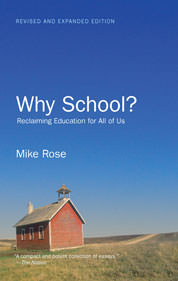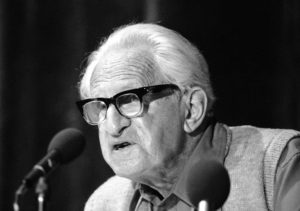MOOCs and Other Wonders: Education and High-Tech Utopia
Deep within our cultural history is a faith in the power of technology to cure social problems.
Editor’s note: The following is an excerpt from education scholar and Truthdig contributor Mike Rose’s book, “Why School?: Reclaiming Education for All of Us,” which is now out in paperback in a new revised and expanded edition.
Deep within our cultural history is a faith in the power of technology to cure social problems. Many of our Utopian visions—from nineteenth century socialist tracts and novels to Silicon Valley’s libertarian futurism—are based on technology. That faith is vibrant today, at times idealistic, at times entrepreneurial, often a blend of the two. Neuroscience will lead to the cure of mental illness and reveal the mystery of consciousness itself. Social media will bring us together across regional and national divides, and the cell phone or tablet computer will provide the platform to lift people in developing countries out of poverty. And, closer to the concerns of this book, online instruction will reduce the cost and improve the quality of education, and high-stakes standardized tests will scientifically measure student learning and teacher effectiveness.
Modern technology, of course, is stunning, and can and should be brought to bear on our social problems, education included. Those who believe deeply in technology’s virtues have reasons for their grand vision. They are well-educated and highly skilled in technology’s devices and systems, and the arguments they offer are articulate and assured. Their education at prestigious schools provides them with potent social networks that contribute to their access to power and philanthropic and venture capital resources. They are positioned to make things happen.
The limitations—and, in some cases I think, dangers—of this faith in technology are contained within its strengths.
The faith in technology can lead to overreach, to a belief that complex human problems can be framed as engineering problems, their social and political messiness factored away. Hand-in-glove is an epistemological insularity, a lack of knowledge about social and cultural conditions—or worse, a willful discounting of those conditions as irrelevant. It is telling how rarely one hears any references to history or culture in the technologists’ discourse. I think the social position of many of the technologists is a factor here: they tend to come from, at the least, middle-class or professional families, and their schooling has sheltered them from intimate knowledge of many of the people they seek to help. Reform movements have often drawn on such elites, and they can bring much needed resources and power to the reform, but their backgrounds can also blind them to conditions on the ground, to the lives they hope to affect.
I want to consider this faith in technology as it relates to education, and I’ll use as my central example MOOCs, or Massive Open Online Courses, which are ever-present in higher education news as I write.
A MOOC is essentially a pre-recorded course, heavy on lecture, so, in that regard, it is not at all new. But it is placed online, making it available to anyone with an Internet connection. The first MOOCs originated in Canada in 2008, then spread to the United States, making a splash as several Ivy League faculty began putting their courses online. “Ivy League for the masses,” announced Time magazine. As MOOCs have developed over the last few years, lectures have been broken up into modular units—easier to process online—and additional instructional materials have been added along with limited means for participants to interact with faculty and students via an electronic forum. There are also attempts, not without considerable complication, to address the issues of testing, grading, and course credit.
Imagine a guy on a remote ranch in Montana or a young woman in Manila learning electrical engineering from MIT’s finest. One catches the idealistic thrill of this idea in Daphne Kohler’s TED talk on MOOCs—Kohler is a distinguished computer scientist at Stanford and a driving force in the MOOC enterprise—as she offers a vision of high-quality education spread across the globe via the Internet, solving the problem of access and availability. Over the last year or so, increasing numbers of colleges and universities have been signing up for MOOCs or even developing their own, and the courses are expanding from the originally top-heavy sciences and engineering to include the social sciences and humanities, and even some remedial courses.
I have been around higher education for a long time, and I can’t recall an innovation taking off like the MOOC has. There are several reasons. The humanitarianism of massive reach and open access across the planet has captured the fancy of big time public voices, including those on the New York Times Opinion Page. Furthermore, as I mentioned earlier, technological idealism readily morphs with entrepreneurship, and many of the MOOC luminaries have formed both for-profit and non-profit companies that engage in the hard sell. There is a lot of hype generated around MOOCs: they are part of a “tsunami” or an “avalanche” about to hit higher education—or they are higher education’s “Napster moment.” The hyperbole has gotten so strong that suddenly some within the MOOC venture are trying to dial it down a notch. A third, and huge, factor is that college administrators and state legislators see MOOCs as a way to reduce the soaring costs of higher education as well as to provide access to high-demand classes.Amid the enthusiasm, there are many concerns about MOOCs, some of which are a function of their rapid spread, from technical and infrastructural problems (predictable when enrollment is in the tens of thousands) to issues of intellectual property, to grading and credit (if I’m at the University of Tennessee, and complete a Harvard course in my computer science major, does that course transfer to my new institution?), to questions of the role and status of faculty at receiving institutions—what role do the computer science faculty and graduate students at Tennessee play if the university subscribes to multiple courses, and will their ranks diminish over time? These are complex issues that may or may not get worked out if MOOCs continue to spread and develop.
But here, I’m particularly concerned with the quality of education possible with MOOCs. As MOOCs grow, it’s fair to assume there will be a predictable range of faculty talent, but let’s give the benefit of the doubt here and grant that MOOC developers will seek skillful teachers. Then the question becomes how well the developers use the considerable capability of instructional technology within the constraints of a massive and open course that, after all, is still a series of modularized lectures. (Some of the stronger critiques of MOOCs come from experts in educational technology who see the MOOC as a fairly primitive form of online instruction.) This technical question rests on two more basic questions that I don’t hear raised much by advocates: What assumptions about learning and what philosophy of education inform the technology?
Perhaps the most frequent criticism of MOOCs comes from college faculty themselves, and, for shorthand, I’ll call it the humanistic argument: Education involves more than watching a lecture on the computer, even if enhanced with options for interaction. What about the spontaneous give and take between teacher and student or student and student? What about the teacher’s in-the-moment assessment of classroom dynamics? This concern, of course, reflects a broader tension of our time between electronic connection versus human touch. The MOOC advocates have several answers to the humanistic argument. The first is that with the right technology, certain kinds of interaction between teachers, teachers’ assistants, and students are achievable, and exist in some MOOCS now. But this interaction occurs within a number of constraints. To my knowledge, no current MOOC encourages a direct exchange between student and professor.
The second counterargument is more convincing, sadly so. The appealing pedagogical portrait conjured in the humanistic complaint is rare when one looks across the full range of classrooms in American higher education. Many students sit through classes that are poorly taught and/or sit in large rooms passively receiving lecture after lecture—if they come to class at all. A well-constructed MOOC would clearly be an improvement. And, a genuine advantage, they could be taken by the increasing numbers of students in American higher education who are older, work, or have families. These students have long provided a powerful rationale for on-line learning in general, and for-profit virtual colleges (such as the University of Phoenix) have targeted them. It is an egalitarian move, then, for less expensive public colleges to open their doors electronically via MOOCs and other online courses, as some have been doing.
The problem, though, is that at this point in mid-2013, the completion rate for MOOCs is a dreary ten percent, and what data we have suggests that many of the people who do complete the courses are people who already hold degrees. Rather than fulfilling the promise of MOOCs providing an entryway to an elite education for the masses, so far they serve as an enrichment for the educated—not a bad thing by any means, but different from the liberatory vision of Professor Kohler’s TED talk.
MOOCs are in their early stages, so the situation is fluid, but if the above data are any indication of demographics and persistence, the prospect of the widespread use of MOOCs in the potentially cost-saving areas of introductory and remedial courses is troubling. To be sure, there is an important role electronic technology can play—is already playing—in such classes, from graphic enhancements to interactive tutorials to platforms enabling and enhancing teacher-student and student-student interaction. But the digital divide is still very much with us, so even tech-savvy students who are poor or who live in remote areas will have trouble both with infrastructure and equipment. I saw such problems continually in inner-city community colleges. And I also witnessed a related difficulty: older students who were not comfortable with the computer avoided or dropped classes that contained any on-line component. The whole world is not wired.Earlier I mentioned the central importance of a theory of learning and philosophy of education when considering the creation and distribution of MOOCs. There is currently a major rethinking of remedial education under way, as well as important discussions about undergraduate education, the role of the humanities, scientific literacy, and more. These discussions are taking place apace with the development of MOOCs, and occasionally serve as material in critical appraisals of MOOCs, but I don’t see these core educational concerns embedded within the rapid development of MOOCs themselves.
What we do have is a fevered and, at least for now, ever-present debate on the business, technology, and infrastructure of the enterprise. But questions about the purpose of education and the way people learn should be integral to the technical and infrastructural deliberations, and the fact that they’re not is partly a reflection of the technological orientation that fuels the MOOC juggernaut. It is telling that the one discussion of learning that we do hear is a pretty reductive one—and it emerges from the promise of “big data” and “data analytics,” another element of our era’s technological fixation. Because so many students will be responding to instructional materials and taking tests, the reasoning goes, we will have truckloads of data on how many people, for example, choose what test answer, find correlations among these choices, possibly see if one teaching method rather than another yields better scores. This approach—and it is offered with great enthusiasm—is riddled with problems. If the past is prologue, the tests will be multiple choice (for physics or for poetry), so we have only a narrow kind of learning and testing to begin with. Furthermore, seeking correlations among multiple choice answers will give us at best a slew of low to modest relationships among test items that will tell us nothing about how students are thinking, or what about a particular thing a professor does led to the correlation. And in line both with the faith in big data and the insularity of technological Utopianism, there is not even an acknowledgement—and possibly no awareness—of the century’s worth of research done by psychologists, anthropologists, and educators on learning. This absence could be a function of disciplinary insularity, but I also think something else is in play, something we see in other domains of contemporary education reform: a dismissal of anything smacking of traditional education, schools of education, or educational research.
***
One reason we don’t hear much extended, historically informed discussion of learning and the purpose of a college education is that such issues are not central to the technological orientation I’ve been discussing. Another is because the main force driving the rush to MOOCs by administrators and legislators is the prospect of saving money. MOOCs in, let’s say, introductory calculus, psychology, and geology could replace individual offerings on multiple campuses, with resulting reductions in faculty—or at least an economical transformation of their roles. In a measured book, Higher Education in the Digital Age, a former president of Princeton, William Bowen, rightly warns of the public backlash that will occur if the rapidly rising cost of higher education is not reigned in. He sees digital technologies, MOOCs among them, as one promising way to contain cost—though he urges caution and research on implementation.
As Bowen admits, the soaring cost of a college education has multiple causes, and a big one is the significant disinvestment of states in public higher education—more than a twenty percent decrease since the 1980s. Whether MOOCs could make a worthwhile difference against such a deficit is an open question. There is another cluster of economic and social issues that MOOCs, if they do take off, could affect, and I’d like to bring this chapter to a close by considering those issues: an interweaving of technology, economics, and prestige and status. As a core example, let’s consider a currently popular MOOC, Harvard political philosopher Michael Sandel’s introductory-level course “Justice.”
Sandel is a distinguished scholar and a fine lecturer: articulate with good presence, able to explain political philosophy cogently. But, and I mean no disrespect in saying this, what he does and how he does it is good, strong traditional lecturing; it is a wonderful skill built on a life of study. But others also do it well, and they aren’t all in the Ivy League; in fact, my high-school senior English teacher and my college philosophy instructor were equally skilled. The MOOC, as conceived now, plays into the pronounced status distinctions among institutions in American higher education—something that itself should be the focus of discussion as we try to continually move the American system toward the egalitarian vision that allegedly defines it. Imagine, as a thought experiment, that a smart and articulate physicist or philosopher from a state college in the Midwest had done one of the first American MOOCs. You can bet that the New York Times crowd would not have written about it and high-tech philanthropies and venture capitalists would not have showered it with money.Equally troubling is that the MOOC also reinforces the phenomenon of the celebrity academic, the “star” and “super star” (even, God help us, “rock star”), words you’ll hear increasingly in academic circles. The fact that the academy has so readily embraced the vocabulary and social dynamics of celebrity culture should be a source of shame and ridicule; instead such celebrity is advanced by the MOOC enterprise.
When you consider the institutional sources of MOOCs and the direction of their distribution, a troubling pattern emerges: the MOOCs originate primarily in elite universities and flow down the status ladder to other less prestigious schools. Seen in an idealistic light, this is a delivery of an “Ivy League education to the masses.” But if done in a way that preserves faculty at elite institutions—even enhances those institutions—while possibly contributing to the reduction of faculty at receiving institutions, and ipso facto, a worsening of student to faculty ratio—well, then, you’ve got the dynamics of inequality at work once again: A supposed egalitarian move increasing the inequality in the kinds of education less privileged students receive. An idealistic intent, as history has repeatedly demonstrated, plays out in real-world economic and socio-political contexts, and those contexts can distort, even reverse, an idealistic purpose.
In the college of the future—and the future is already here—we will most likely see some variation of a MOOC along with other on-line modes of instruction. And traditional classrooms will be enhanced by various electronic platforms to aid in everything from presenting course materials, to facilitating discussion, to keeping records. The fundamental question is how all these media and formats will be integrated into a comprehensive and coherent course of study. The problem with MOOCs right now is that they are being heralded as yet another technological wonder to save us from a web of complex social and educational problems: rising costs, shrinking budgets, overcrowding and restricted access. For all the caveats and disclaimers that everyone on all sides of any educational reform issue keeps offering about there being no miracle cure, no magic bullet, we keep rushing toward them, solemnly intoning that there is no quick fix—and at the next press conference announcing the new game-changer. When will we stop this distracting and, in fact, expensive worship of the new technological system or device and settle into the less enthralling but more substantial recognition that MOOCs—or any other wonder, from digital games to the most recent statistical procedure—will only be as useful as the thinking about its use, the depth of learning we want to achieve, the kind of education we want to foster.
Your support matters…Independent journalism is under threat and overshadowed by heavily funded mainstream media.
You can help level the playing field. Become a member.
Your tax-deductible contribution keeps us digging beneath the headlines to give you thought-provoking, investigative reporting and analysis that unearths what's really happening- without compromise.
Give today to support our courageous, independent journalists.






You need to be a supporter to comment.
There are currently no responses to this article.
Be the first to respond.